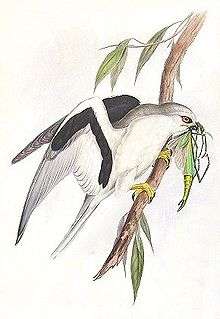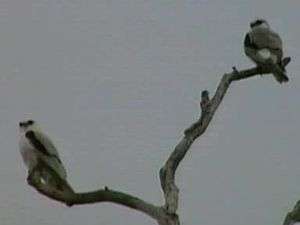Letter-winged kite
| Letter-winged kite | |
|---|---|
 | |
| Scientific classification | |
| Kingdom: | Animalia |
| Phylum: | Chordata |
| Class: | Aves |
| Order: | Accipitriformes |
| Family: | Accipitridae |
| Genus: | Elanus |
| Species: | E. scriptus |
| Binomial name | |
| Elanus scriptus (Gould, 1842) | |
The letter-winged kite (Elanus scriptus) is a small, rare and irruptive Australian raptor with a core range in central Australia. The adult is a small and graceful, predominantly pale grey and white, bird with black shoulders and red eyes. It is similar in appearance to the black-shouldered kite except for a very distinctive black underwing pattern of a shallow ‘M’ shape, seen when in flight. Roosting during the day in well-foliaged trees and hunting at night, it is the world's only fully nocturnal Accipitriformes or Falconiformes raptor. Like all the elanid kites, it is a specialist predator of rodents, which it hunts by hovering in mid-air above grasslands and fields.
Taxonomy
The letter-winged kite was originally described by ornithologist John Gould in 1842. Its specific name is from the Latin word scriptum meaning "written" or "marked".[2] It is one of four species of small predominantly white-plumaged raptors in the genus Elanus. A taxonomic proposal based on DNA studies has recommended classifying these kites as a separate family (Elanidae).[3] A 2004 molecular study of cytochrome-b DNA sequences shows them to have split off from typical hawks and eagles at an earlier date than the Osprey, which has been classically classified in its own family.[4]
In Central Australia, southwest of Alice Springs, the Pitjantjatjara term for the letter-winged kite is nyanyitjira.[5]
Description
Measuring 33 to 38 cm in length (13–15 in) with a wingspan of 85 to 95 cm (34–38 in), and weighing around 291 g (10.3 oz), the adult letter-winged kite is a pale grey with a white head and white underparts. It bears a characteristic long black leading edge of the inner wing, which resembles a letter 'M' or 'W' when flying. When perched, this gives them their prominent black "shoulders". It has red eyes, with black eye patches surrounding. Their nostrils are yellow and the sharp hooked beaks are black. The legs and feet are also yellow, and the feet have three toes facing forwards and one toe facing backwards.[6] The female can be distinguished by a greyer crown.[7]
The 'M' or 'W' on the underside of its wing, and lack of black wing tips help distinguish it from the black-shouldered kite. In flight, it beats its wings more slowly and deeply. Finally, the latter species is diurnal, not nocturnal.[7]
Its call is a chicken-like chirping or a repeated loud kacking.[6]
Distribution and habitat
The usual habitat of the letter-winged kite is semi-arid open, shrubby or grassy country, across the arid interior of the continent, such as the Channel Country and Gulf Country of Western Queensland and into the Northern Territory. Its range may spread south with rodent plagues.[8] The species has been recorded in the vicinity of Broken Hill in far western New South Wales,[9] and a dead bird recorded in a street in Inverell in the north of the state in 1965 and another spotted there a year later,[10] as well as Lake Eyre in northern South Australia.
Food and feeding
The letter-winged kite is the only fully nocturnal member of its family.[7] Its principal prey is the Long-haired Rat, Rattus villosissimus. When population numbers of this rodent build up, following good rainfall, the kites are able to breed continuously and colonially so that their numbers increase in parallel. When the rodent populations decline, the now superabundant kites may disperse and appear in coastal areas far from their normal range in which, though they may occasionally breed, they do not persist and eventually disappear.[7] One central Australian study over two and a half years found the kites had relocated to an area within six months of a rodent outbreak starting.[11]
Across Central Australia, it shares its habitat with another nocturnal rodent hunter, the barn owl (Tyto alba), with the latter species preferring larger rodents such as the plains rat (Pseudomys australis) whereas the kite took all species, including the sandy inland mouse (Pseudomys hermannsburgensis) and spinifex hopping mouse (Notomys alexis), on availability.[12] Overall, letter-winged kites average one rodent consumed a day. Other predators sharing its habitat include the dingo, feral cat and fox.[11]
Letter-winged kites have also been recorded hunting the introduced house mouse Mus musculus in north-eastern South Australia.[13]
Breeding

The breeding season is usually July to November. The nest is a large untidy shallow cup of sticks usually in the foliage near the top of trees, some five metres (15 ft) or higher off the ground. It is lined with green leaves and other material such as regurgitated pellets. Multiple nests may be seen in single trees in cases of rodent plagues and hence abundance of food. The clutch consists of three to four, or rarely five or even six, dull white eggs measuring 44 x 32 mm with red-brown blotches and tapered oval in shape. The markings are often heavier around the larger end of the egg.[8] The female incubates the eggs for 30 days, and nestlings remain in the nest for around 32 days.[7]
References
- ↑ BirdLife International (2012). "Elanus scriptus". IUCN Red List of Threatened Species. Version 2013.2. International Union for Conservation of Nature. Retrieved 26 November 2013.
- ↑ Simpson DP (1979). Cassell's Latin Dictionary (5th ed.). London: Cassell Ltd. p. 539. ISBN 0-304-52257-0.
- ↑ Debus, Stephen (June 2004). "Australian Raptors: The Big Picture" (PDF). Boobook. The Australian Raptor Association. 22 (1): 4–5.
- ↑ Wink M; Sauer-Gürth H (2004). "Phylogenetic relationships in diurnal raptors based on nucleotide sequences of mitochondrial and nuclear marker genes". In Chancelor RD; Meyburg B-U. Raptors Worldwide (PDF). Berlin: The World Working Group on Birds of Prey and Owls. pp. 483–98. Retrieved 6 November 2015.
- ↑ Cliff Goddard (1992). Pitjantjatjara/Yankunytjatjara To English Dictionary (2nd ed.). Alice Springs: Institute for Aboriginal Development. p. 95. ISBN 0-949659-64-9.
- 1 2 Slater, Peter (1970). A Field Guide to Australian Birds:Non-passerines. Adelaide: Rigby. p. 239. ISBN 0-85179-102-6.
- 1 2 3 4 5 "Letter-winged Kite". Birds in Backyards. Birds Australia, Australian Museum. 11 November 2009. Retrieved 10 May 2010.
- 1 2 Beruldsen, Gordon (2003). Australian Birds: Their Nests and Eggs. Kenmore Hills, Qld: self. p. 199. ISBN 0-646-42798-9.
- ↑ Broken Hill Complex - biodiversity
- ↑ Baldwin, Merle (1975). "Birds of Inverell District". Emu. 75 (2): 113–20. doi:10.1071/MU9750113.
- 1 2 Pavey CR, Eldridge SR, Heywood M (2008). "Journal of Mammalogy". Journal of Arid Environments. 89 (3): 674–83. doi:10.1644/07-MAMM-A-168R.1.
- ↑ Pavey CR, Gorman J, Heywood M (2008). "Dietary overlap between the nocturnal letter-winged kite Elanus scriptus and barn owl Tyto alba during a rodent outbreak in arid Australia". Journal of Arid Environments. 72 (12): 2282–86. doi:10.1016/j.jaridenv.2008.07.013.
- ↑ Baker-Gabb DJ, Pettigrew JD (1982). "Non-breeding diet of the Letter-winged Kite in north-eastern South Australia". Corella. 6: 19–20.
- BirdLife International (2006) Species factsheet: Elanus scriptus. Downloaded from http://www.birdlife.org on 15/11/2006
- Marchant, S.; & Higgins, P.J. (Eds). (1993). Handbook of Australian, New Zealand and Antarctic Birds. Vol,2: Raptors to Lapwings. Oxford University Press: Melbourne. ISBN 978-0-19-553069-8
| Wikimedia Commons has media related to Elanus scriptus. |
| Wikispecies has information related to: Elanus scriptus |
